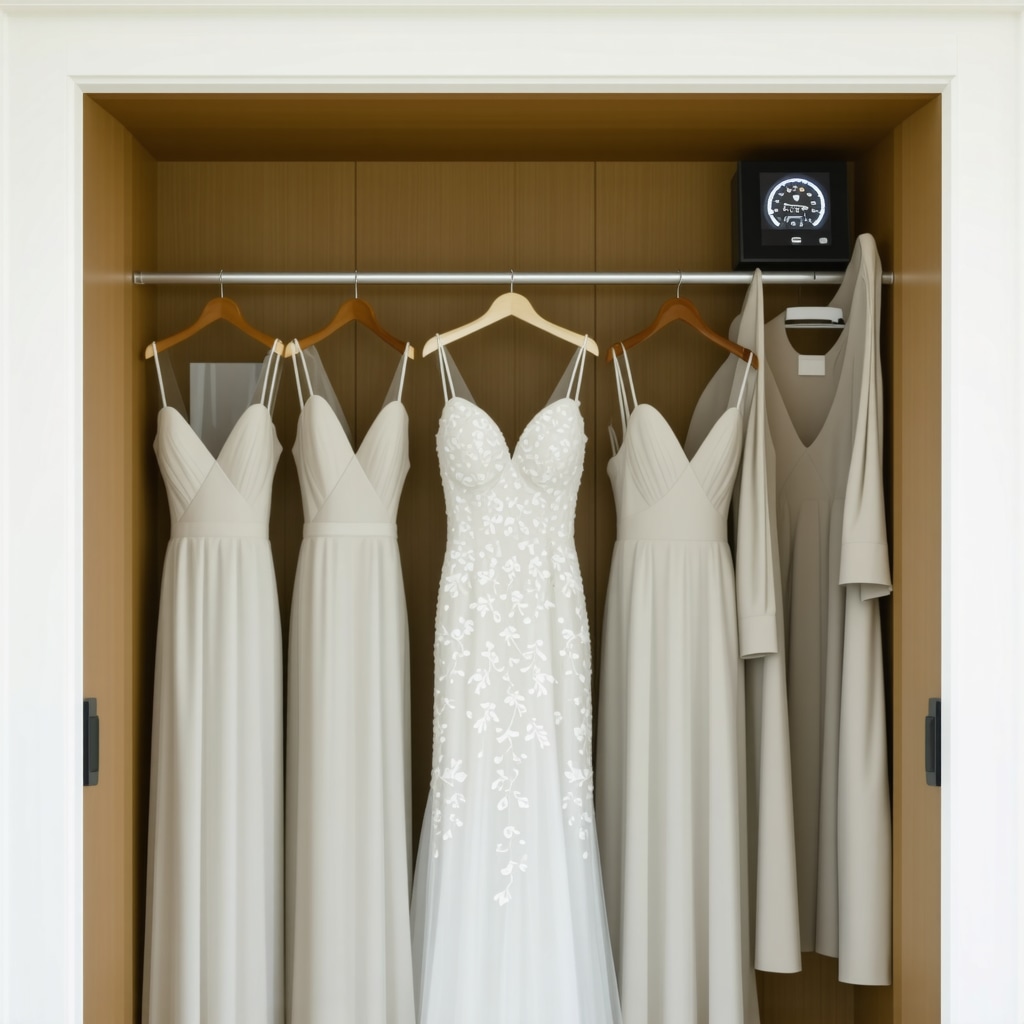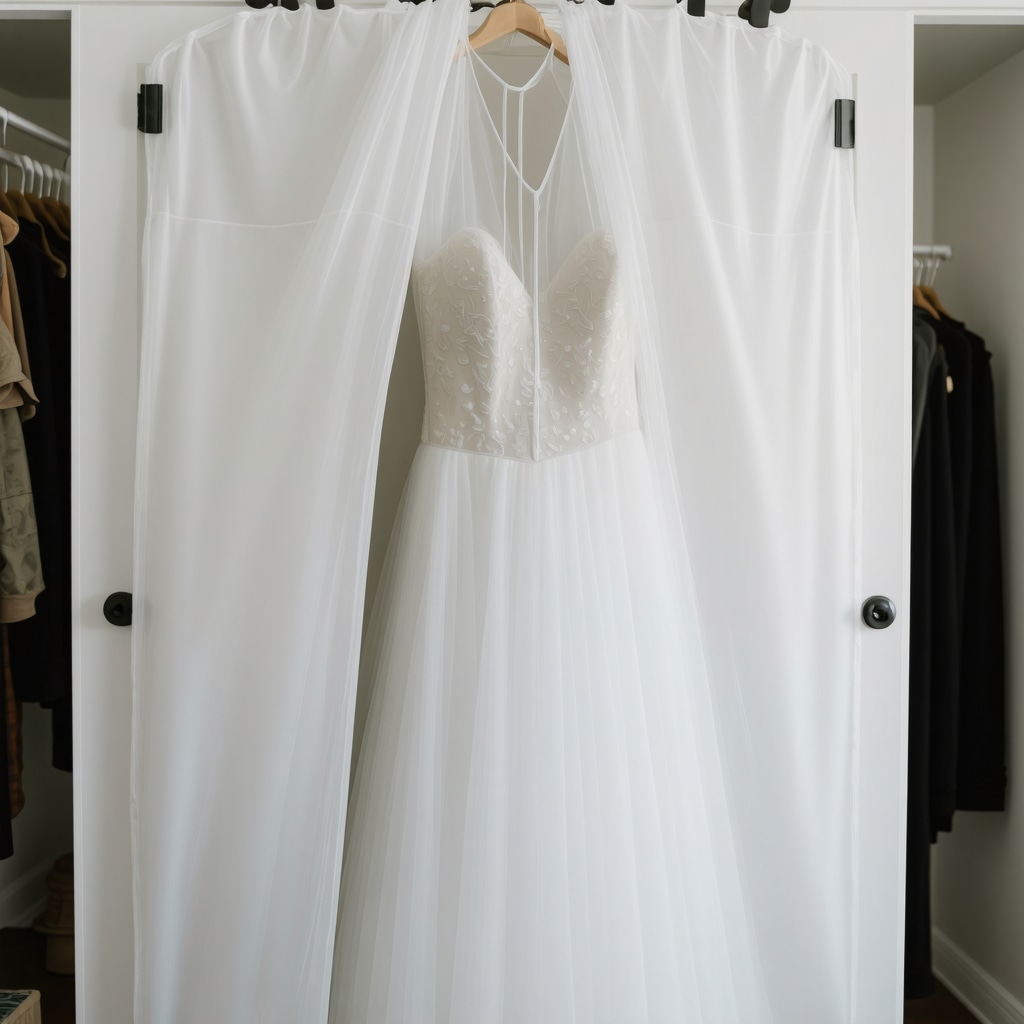Elevating Wedding Gown Preservation: Contextualizing Challenges in Wiregrass Area FL
Preserving a wedding gown transcends simple storage; it is a meticulous process demanding expert knowledge, especially in unique climates like Wiregrass Area, Florida. The region’s high humidity and variable temperatures introduce complex risks—such as mold growth and fabric degradation—that require specialized preservation strategies beyond standard practices. Understanding these environmental nuances is crucial for long-term maintenance of couture bridal gowns.
Advanced Fabric Care: Tailoring Preservation to Bridal Gown Materials
Wedding gowns often comprise delicate fabrics such as silk, satin, lace, and tulle, each requiring distinct cleaning and preservation methods. In Wiregrass Area FL, the interaction of humid air with organic fibers can accelerate yellowing and weakening of textile fibers. Professional-grade cleaning techniques, including eco-friendly dry cleaning and pH-neutral detergents, are essential to mitigate oxidative damage and maintain fabric integrity. Employing inert, acid-free preservation boxes further protects against light and airborne pollutants, critical in this locale.
What Are the Most Effective Preservation Methods for Wedding Gowns in Humid Climates Like Wiregrass Area?
Experts recommend a multi-step approach combining immediate post-wedding professional cleaning with controlled environment storage. This includes:
- Utilizing advanced solvent-based dry cleaning that targets common stains such as perspiration and grass, frequent in outdoor weddings.
- Employing silica gel packets or humidity absorbers within sealed preservation containers to regulate moisture.
- Ensuring gowns are stored flat or gently padded to avoid stress on seams and embellishments.
These steps significantly prolong the lifespan and visual appeal of cherished bridal gowns despite the climatic adversities inherent to Wiregrass Area.
Integrating Sustainable and Local Expertise: Choosing Preservation Services Near You
Wiregrass brides benefit from selecting local preservation services familiar with Florida’s environment. Local experts offer bespoke solutions that incorporate sustainable cleaning techniques tailored for environmental safety and fabric longevity, such as those outlined in Tampa Bay area’s eco-friendly wedding dress care practices. Leveraging regional knowledge ensures precision in stain removal and fabric protection, enhancing preservation outcomes.
Professional Insights: Why Expert Preservation Transforms Bridal Heirlooms
Preservation is not merely about aesthetics but about safeguarding the gown’s structural and historical value. Expert conservators use archival quality materials and climate-controlled facilities, aligning with standards cited in textile conservation literature published by the Textile Museum. Their methodologies reduce deterioration risks such as fiber embrittlement and photodegradation, ensuring gowns remain pristine for future generations.
Call to Action: Explore In-Depth Preservation Techniques and Share Your Expertise
For comprehensive strategies on bridal gown preservation tailored to Florida’s climate, explore our detailed guide on wedding gown preservation in Wiregrass Area. Professional conservators and brides alike are encouraged to contribute insights and experiences to foster a community dedicated to bridal textile longevity.
Innovations in Climate-Controlled Storage Solutions for Bridal Gowns
In regions like Wiregrass Area, FL, where humidity and temperature fluctuations are persistent, traditional storage methods often fall short. Advanced climate-controlled storage units now employ precise humidity and temperature regulation, preventing mold, mildew, and fabric degradation. These units are designed to maintain relative humidity levels around 50% and temperatures near 65°F, which research indicates as optimal for textile preservation. Incorporating these technologies helps brides safeguard their gowns against environmental stressors inherent in Florida’s climate.
Specialized Stain Removal: Addressing Florida’s Outdoor Wedding Challenges
Outdoor weddings in Florida frequently expose gowns to challenging stains such as grass, mud, perspiration, and tropical fruit juices. Expert cleaners utilize enzymatic and solvent-based treatments tailored to each stain type, ensuring effective removal without compromising delicate fabrics. For example, grass stains, rich in chlorophyll, require targeted enzymatic action, while oil-based stains from sunscreen or insect repellent demand solvent precision. These sophisticated techniques are essential to preserve the gown’s pristine condition post-ceremony.
How Do Emerging Eco-Friendly Cleaning Methods Enhance Wedding Dress Preservation in Humid Environments?
Eco-friendly cleaning innovations integrate sustainable solvents and biodegradeable detergents that are not only gentle on delicate wedding fabrics but also reduce chemical residues that can attract moisture or cause fiber damage. These methods align with the growing demand for green bridal gown care, particularly in Florida’s humid climate, where chemical buildup can exacerbate deterioration. According to the National Center for Biotechnology Information, sustainable textile cleaning approaches improve long-term fabric resilience and reduce environmental impact, a dual benefit that modern brides increasingly value.
Leveraging Local Expertise: Finding Trusted Preservation Services in Tampa Bay
Engaging local professionals who understand Tampa Bay’s microclimate nuances is vital. These experts offer tailored services, from urgent same-day cleaning to luxury couture gown care, ensuring that each gown receives personalized attention. To explore such specialized options, brides can visit expert wedding dress cleaning services in Tampa, where cutting-edge preservation meets local knowledge.
Invitation to Share and Learn: Join the Community of Bridal Preservation Experts
We invite brides, conservators, and textile care specialists to share their experiences, tips, and questions regarding wedding gown preservation in Florida’s challenging climate. Join the conversation by commenting below or sharing this article with fellow brides who value sustainable and expert gown care. For further insights, explore our complete guide on how to preserve your wedding gown museum-quality in Tampa Bay to deepen your knowledge and protect your cherished heirloom.
Microclimate Mastery: Optimizing Storage Conditions Beyond Standard Guidelines
The Wiregrass Area’s microclimate nuances demand storage solutions that exceed traditional preservation protocols. While maintaining 50% relative humidity and 65°F temperature is ideal, fluctuations caused by seasonal storms or daily temperature swings necessitate dynamic environmental monitoring. Advanced hygrometers paired with smart climate control devices enable real-time adjustments, preventing condensation and microbial growth which classic static environments cannot address. Moreover, incorporating UV-filtering storage cases mitigates photodegradation risks from incidental light exposure, a subtle but critical factor often overlooked in home storage setups.
How does microclimate variability in Florida affect long-term textile preservation?
Florida’s microclimates introduce variables such as salt air exposure near coastal areas, elevated ambient temperatures in urban heat islands, and episodic high humidity spikes from tropical weather. These conditions accelerate oxidative and hydrolytic degradation pathways in fibers like silk and lace. As detailed by the American Institute for Conservation, adaptive preservation strategies incorporating localized environmental data significantly improve textile longevity by preempting damage vectors unique to such climates.
Innovative Biotechnological Approaches to Stain Removal: Enzymes and Beyond
Emerging biotechnologies are revolutionizing stain removal in delicate bridal fabrics. Enzymatic cleaners, engineered to target specific organic compounds like chlorophyll or sebaceous oils, deliver precision cleaning with minimal fiber disruption. Recent advances include immobilized enzyme formulations that sustain activity longer and reduce chemical residues, enhancing fabric preservation. Additionally, nanotechnology-based cleaning agents enable deep stain penetration and removal while preserving surface treatments and embroidery, critical for couture gowns.
These innovations not only elevate stain removal efficacy but align with green chemistry principles, reducing environmental impact—a growing priority for eco-conscious brides and conservators alike.
Sustainable Preservation Packaging: Materials Science Meets Bridal Care
Material selection for preservation packaging is evolving with a focus on sustainability and chemical inertness. Bio-based, acid-free, lignin-free paper and archival polyester films now offer robust protection against pollutants and moisture while minimizing ecological footprints. These materials resist off-gassing which can degrade delicate textiles over time. Furthermore, research into breathable yet protective textile wraps infused with antimicrobial agents offers promising avenues to inhibit microbial growth without harsh chemicals.
What are the latest materials recommended for eco-friendly bridal gown storage?
Leading conservation research endorses archival-grade, buffered acid-free materials combined with polyethylene or polypropylene sleeves that provide physical and chemical protection. According to the American Conservation Association, integrating antimicrobial textile wraps with humidity buffering capabilities represents a frontier in sustainable preservation packaging, particularly suited for humid environments like Florida.
Collaborative Expertise: Building Networks Between Brides, Conservators, and Scientists
The complexity of bridal gown preservation in climates like Wiregrass Area underscores the importance of multidisciplinary collaboration. Establishing networks that connect brides, textile conservators, and materials scientists fosters knowledge exchange on innovative practices and localized challenges. Such collaborative platforms enable the development of customized preservation plans integrating cutting-edge science with practical experience, ensuring gowns are protected holistically.
Engage with expert communities and participate in workshops or webinars focusing on textile conservation tailored for Florida’s environment. These forums offer invaluable insights into emerging technologies and preservation philosophies that can transform how bridal heirlooms endure.
Invitation to Explore and Contribute to Bridal Gown Preservation Science
We encourage readers to delve deeper into advanced preservation methodologies by accessing our comprehensive resource library on advanced wedding gown care specific to Florida’s climate challenges. Share your experiences or pose questions to our panel of conservation experts to actively contribute to evolving best practices. Together, we can safeguard the legacy of bridal textiles for generations to come.

Harnessing Nanotechnology for Textile Integrity in Challenging Climates
The integration of nanotechnology into wedding gown preservation heralds a new frontier for maintaining textile integrity amidst the humid conditions of Wiregrass Area, FL. Nanoparticles embedded within protective coatings provide an ultra-thin barrier against moisture ingress and microbial growth, effectively mitigating common deleterious effects such as hydrolysis and fungal colonization. This approach allows for the preservation of intricate embroidery and delicate lace without compromising the fabric’s tactile qualities or breathability.
Multifactorial Risk Assessment: Predictive Modeling for Gown Longevity
Advanced preservation necessitates predictive models that assimilate environmental data, fabric composition, and historical degradation patterns. Utilizing machine learning algorithms trained on extensive textile conservation datasets enables precise estimation of a gown’s vulnerability to humidity-induced damage, photodegradation, and mechanical stress. This facilitates proactive interventions tailored to individual gowns, optimizing preservation timelines and resource allocation.
How can AI-driven analytics transform personalized wedding gown care in fluctuating Florida microclimates?
Artificial Intelligence (AI) enhances personalized bridal gown preservation by continuously analyzing real-time environmental inputs combined with gown-specific metadata such as fiber type, weave density, and prior cleaning history. According to a recent study published by the Textile Conservation Institute, AI-powered sensors integrated into storage units can autonomously adjust humidity and temperature settings, predict imminent degradation risks, and recommend targeted conservation treatments. This dynamic adaptability is paramount for managing the unpredictable microclimates characteristic of Florida, ensuring gowns are preserved under optimal conditions at all times.
Innovations in Photoprotective Storage: Beyond UV Filtering
While UV-filtering storage cases are standard, emerging photoprotective technologies incorporate visible light attenuation and blue light absorption to prevent photobleaching and fiber weakening. These multi-spectrum protective materials use advanced polymer composites that selectively block deleterious wavelengths without diminishing visibility for inspection. Such innovations significantly extend the lifespan of dyed fabrics and embellished textiles exposed to incidental light in residential storage.
Advanced Biocidal Treatments: Balancing Preservation with Textile Safety
New-generation biocidal agents derived from botanical extracts offer effective antimicrobial protection without the toxicity associated with traditional chemicals. These agents are formulated to be non-invasive, preserving the gown’s biochemical and mechanical properties. Their incorporation into preservation packaging materials creates an inhospitable environment for mold and bacteria, a critical factor in managing Florida’s pervasive humidity challenges.
Collaborative Platforms: Leveraging Digital Communities for Knowledge Exchange
The complexity of textile preservation in humid climates benefits from collaborative digital platforms where conservators, brides, and material scientists share data, treatment outcomes, and innovations. Platforms utilizing blockchain technology ensure traceability and authenticity of preservation records, fostering trust and facilitating longitudinal studies on gown longevity. Such networks empower stakeholders with up-to-date methodologies and localized best practices, elevating the standard of bridal gown care globally.
Call to Action: Engage with Pioneering Preservation Science Today
Delve into the forefront of wedding gown preservation by exploring our specialized resource hub at advanced wedding gown care. Join the vanguard of brides, conservators, and scientists collaborating to refine preservation techniques tailored for Florida’s unique climate. Share your insights or challenge prevailing paradigms by participating in our upcoming webinars and expert forums. Together, we can ensure the enduring legacy of bridal heirlooms through cutting-edge science and community expertise.

Expert Insights & Advanced Considerations
Microclimate-Specific Storage Protocols Enhance Longevity
Recognizing the unique microclimatic conditions of Wiregrass Area, FL, adaptive storage solutions that dynamically regulate humidity and temperature are essential. Static environments risk condensation and microbial growth, whereas smart climate-controlled units maintain optimal conditions—approximately 50% relative humidity and 65°F—to prevent fiber degradation. Integration of UV-filtering materials further mitigates photodegradation, preserving delicate lace and silk embroidery.
Enzymatic and Nanotechnology-Based Cleaning Elevate Stain Removal Efficacy
Advanced biotechnological approaches, including immobilized enzymatic cleaners and nanotechnology-infused agents, target organic and oil-based stains with precision, minimizing fiber damage. These innovations align with sustainable practices, reducing chemical residues that exacerbate fabric deterioration in humid environments. Their implementation is crucial for maintaining couture gowns exposed to Florida’s outdoor wedding challenges.
Collaborative Multidisciplinary Networks Foster Preservation Excellence
Engagement among brides, textile conservators, and materials scientists through digital platforms revolutionizes preservation strategies. Sharing localized data, treatment outcomes, and innovations enables tailored conservation plans responsive to Florida’s environmental stressors. Blockchain-enabled traceability further ensures the authenticity and integrity of preservation records, supporting longitudinal gown care.
AI-Driven Predictive Modeling Enables Personalized Preservation
Artificial Intelligence integrated with real-time environmental sensors empowers proactive gown care by anticipating degradation risks based on fabric composition and local climate fluctuations. Such data-driven interventions optimize resource allocation and extend gown longevity, representing a paradigm shift in personalized bridal textile conservation.
Curated Expert Resources
- American Institute for Conservation (AIC): A comprehensive repository on textile preservation techniques and environmental control guidelines, invaluable for advanced practitioners.
- Textile Museum Conservation Collection: Offers detailed methodologies on archival materials and climate-controlled storage, instrumental for maintaining structural gown integrity.
- National Center for Biotechnology Information (NCBI): Publishes research on sustainable textile cleaning and biotechnological stain removal innovations, supporting eco-conscious preservation approaches.
- Textile Conservation Institute: Provides insights into AI applications in textile preservation, including sensor integration and predictive analytics tailored to microclimates.
- Wedding Dress Cleaning Tampa – Eco-Friendly Care (Explore eco-friendly wedding dress care in New Tampa, FL): Local expertise emphasizing sustainable and climate-appropriate gown maintenance techniques.
Final Expert Perspective
Wedding gown preservation in Wiregrass Area, FL demands a nuanced understanding of environmental dynamics, fabric sensitivities, and cutting-edge conservation technologies. By synthesizing microclimate-aware storage, biotechnological stain remediation, AI-driven predictive care, and collaborative knowledge sharing, stakeholders can significantly enhance the longevity and heritage value of bridal heirlooms. For brides and conservators committed to excellence, engaging with specialized resources such as museum-quality preservation guides and professional cleaning services is paramount. We encourage you to deepen your expertise, contribute insights, and embrace innovative strategies that safeguard your cherished wedding gowns against Florida’s climatic challenges with precision and sustainability.

